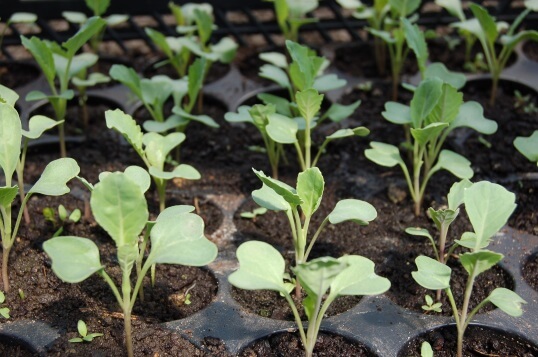How to Sow Seeds Indoors
The dates recommended to sow seeds indoors here in East Tennessee are between February 6th and February 20th. This is for cold hardy plants. Broccoli, Collard Greens, Egg Plant, Kale, Kohlrabi, Lettuce, Mustard, Peppers, Cauliflower, Spinach and Tomatoes can all be started indoors in February.
If you’re new to starting seeds it’s best not to take on too much. Start a couple of dozen plants in 3 or 4 varieties while you learn how it works. Starting seed is a simple process. All you need is a proper growing medium, containers, light, warmth, water, and attention.
Growing Medium
Seeds are delicate. It’s best to start them in a fresh sterile seed-starting mix. There are special seed-starting mixes on the market, but fresh potting soil from a reputable supplier will do just fine. You should not use last year’s potting soil or soil from the garden to sow seeds indoors. There are too many fungus and other pathogens that could infect and kill your plants before they get started. Seeds contain their own nutrients so fertilizer is not necessary.
Growing Containers
Anything that will hold growing medium can work to start your seeds. Here at Willow Ridge Garden Center we sell a 12 pack of plantable 2 ½ inch pots for $1.99 and 8 packs of 3.25 inch pots for the same price. The beauty of these is that once you’re ready to plant your plants in the garden, you simply plant the container that they have been grown in. This way the young plants aren’t stressed by being taken out of the container in which they were grown. However, any kind of container will do. You can use the pots from last year’s annuals or your used yogurt containers. The important thing is to sterilize the containers. Cleaning them in a solution of 1 part bleach to 9 parts water will do the trick. The containers need to have good drainage. So with those yogurt containers, make some holes in the bottom. The containers shouldn’t be more that 3 or 4 inches across
You can also buy seed starting kits. We have a good one here at Willow Ridge. You can also make one yourself. Here’s what you need.
- Container to start the seeds and the growing medium
- A shallow water proof tray to hold them.
- A clear lid to hold in humidity (this can be a plastic bag) during the early stages of germination, once the plants have germinated and are 1 to 2 inches tall, you can take off the lid
How Much Light?
When you sow seeds indoors, light becomes a very important part to the equation. Do you use Natural Light, Artificial Light, Both?
Natural Light
Seedlings need lots of light, 16 to 18 hours of light a day. If you’re going to use natural light, a south facing window that gets lots of light can do for a handful of plants. They need to be turned every day or two, so they won’t start leaning toward the sun.
Artificial Light
Most gardeners use artificial light. We sell and excellent grow light system that has everything you need to ensure excellent growth of your seedlings. This system cost $89.99. There are systems that go for as much as $500.
Another alternative is to build one yourself. You can get from your local home improvement store a fluorescent shop light (I recommend the double light fixture). Using fluorescent bulbs T-12 and T-8 work best. By using one of each bulb you get a wider spectrum of light because one is a cool-white and the other a red-light tube. You will need to raise the light as the plants grows. The light should be 3 or 4 inches above the plants as they grow. The best way to adjust the light is to use link chain that can attach to the light and be suspended from frame that has two S-hooks attached. Move the light by moving the links as the plants grow. Another alternative is to attach the S-hooks to the bottom of a table and suspend the light from there with the plants being on the floor.
A lamp timer can be a big help. A lamp timer will insure that you won’t’ forget to turn off the light for the needed 6 to 8 hours each day.
How Much Water do Seeds Need?
The seeds should be sowed in a moist growing medium. Cover the container to hold in humidity while the seeds germinate. As mentioned earlier, cover with a clear plastic cover or a clear plastic bag. Once the seeds sprout, uncover the container and water from the bottom. Never water from the top. It courts disease (especially a fungus disease called “damping off”).
Make sure the seedlings have good air circulation.
How Often Should I Check My Seeds?
Daily. This is really important. Why? For a number of reasons.
- See if the seeds have sprouted and it’s time to take the cover off.
- Check to see the plants are moist.
- To check to see if the light needs to be raised and stay just the right distance above the plants.
- Another reason is to make sure the lights and timer hasn’t malfunctioned.
- If the plants are in the window, they will need to be turned daily.
A special thanks to the folks a Burpee for their suggestions in putting this blog together.
If you’re into growing your own food, check this out! Microgreens

